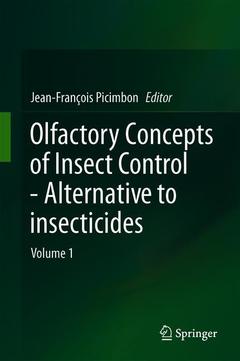Description
Olfactory Concepts of Insect Control - Alternative to insecticides, 1st ed. 2019
Volume 1
Coordinator: Picimbon Jean-François
Language: English
Subjects for Olfactory Concepts of Insect Control - Alternative to...:
225 p. · 15.5x23.5 cm · Hardback
Description
/li>Contents
/li>Comment
/li>
Evolution gave rise to a prominent insect diversity at every level of ecological niche. Since then, hordes of insects have threatened human and cattle health as well as most of all green lands and agricultural crops. Now, the insect problem expands from many mutant forms of yellow dengue fever mosquitoes to highly-resistant larvae of most all various phytophageous species. The tremendous expansion of insects is due not only to an increasing resistance capacity to insecticides, but also to a strong capacity for adapting to different climate and environmental changes, including global warming. Obviously insects display a number of rudimentary systems to build an extremely efficient organism to survive in a changing world. In many species, one pheromone molecule is enough to trigger mating behavior. Therefore, insects have become crucial models not only for evolutionary studies, but also for understanding specific mechanisms underlying sensory-based behaviors. Most of insect species such as ants, beetles, cockroaches, locusts, moths and mosquitoes largely rely on olfactory cues to explore the environment and find con-specifics or food sources. A conglomerate of renowned international scientific experts is gathered to expose the insect problem on the various continents of the planet and propose an alternative to the use of toxic insecticides. Sex pheromones, specific chemical signals necessary for reproduction, and pheromone detection in insects are described with full details of the olfactory mechanisms in the antennae and higher centers in the brain. Thus, new synthetic pheromones and/or plant odors with specific molecular target sites in the insect olfactory system are proposed for sustainable development in agricultural and entomological industries. Disrupting insect pheromone channels and plant odor detection mechanisms is solemnly envisioned as a unique way to control invasive insect pest species while preserving human and environment safety.
1 The spread of mosquito-borne diseases: a major and global public health problem - Anubis Vega Rúa and Bernard A. Okeh
2 Locusts in the world - David Hunter
3. Effects of pesticides on the environment and insecticide resistance- Gaëlle Le Goff and Maeva Giraudo
4 Discovery and development of microbial biological control agents - Alejandro P Rooney, Mark A Jackson, Christopher A Dunlap, Robert W Behle and Ephantus J Muturi5 Fall armyworm (FAW; Lepidoptera, Noctuidae): moth oviposition and crop protection - Camilo Ayra-Pardo and Orlando Borras-Hidalgo
6 Olfaction as a target for control of honeybee parasite mite Varroa destructor - Victoria Soroker, Nitin Kumar Singh, Nurit Eliashand Erika Plettner
7 Circadian and seasonal timing of insect olfactory systems - Sakiko Shiga
8 Molecular basis of pheromonogenesis regulation in moths - J. Joe Hull and Adrien Fónagy
Current status of research about insects
Full-description of the insect olfactory system
New insect pest control methods, alternative to insecticide
These books may interest you

Molecular Basis of Olfaction 135.60 €



